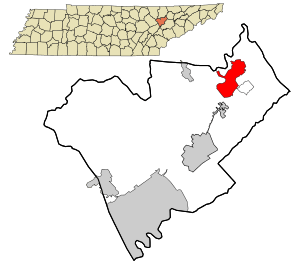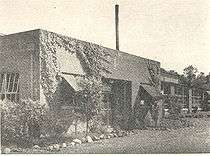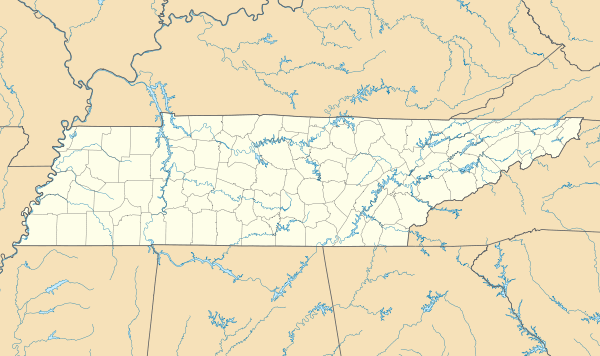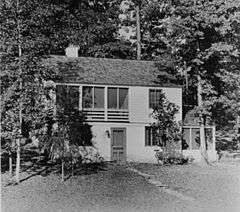Norris, Tennessee
| Norris, Tennessee | |
|---|---|
| City | |
|
Post office and Archer's Food Center in Norris | |
 Location in Anderson County and the state of Tennessee. | |
| Coordinates: 36°11′58″N 84°4′9″W / 36.19944°N 84.06917°WCoordinates: 36°11′58″N 84°4′9″W / 36.19944°N 84.06917°W | |
| Country | United States |
| State | Tennessee |
| County | Anderson |
| Established | 1933 |
| Incorporated | 1949 |
| Named for | George W. Norris |
| Government | |
| • Mayor | Chris Mitchell |
| • City Manager | Tim Hester |
| Area | |
| • Total | 7.2 sq mi (18.6 km2) |
| • Land | 7.2 sq mi (18.6 km2) |
| • Water | 0.0 sq mi (0.0 km2) |
| Elevation | 1,073 ft (327 m) |
| Population (2010) | |
| • Total | 1,491 |
| • Density | 207/sq mi (80.1/km2) |
| Time zone | Eastern (EST) (UTC-5) |
| • Summer (DST) | EDT (UTC-4) |
| ZIP code | 37705, 37828 |
| Area code(s) | 865 |
| FIPS code | 47-53600[1] |
| GNIS feature ID | 1295831[2] |
| Website |
www |
Norris is a city in Anderson County, Tennessee, United States. Its population was 1,491 at the 2010 census.[3] It is included in the Knoxville, Tennessee Metropolitan Statistical Area.
Norris was built as a model planned community by the Tennessee Valley Authority (TVA) in 1933 to house workers building Norris Dam on the Clinch River. It is named in honor of Nebraska Senator George W. Norris, a long-term supporter of the TVA.
History
TVA chairman Arthur Morgan envisioned Norris as a model of cooperative, egalitarian living.[4] The city design was developed by TVA staff,[5] who loosely based their design on the English garden city movement of the 1890s. Winding roads followed the contour of the terrain. Houses did not always face the street. A central common green and a belt of rural land around the town were reserved for use by residents. The houses, which were some of the first all-electric homes, were built using local wood and stone, according to twelve basic house designs that each included a porch and fireplace. Different exterior materials were used for visual variety.[5][6]

Norris represents the first use of greenbelt design principles in a self-contained town in the United States. The town was the first in Tennessee to have a complete system of dial telephones. Norris Creamery was the first milk-producing plant in the world to be powered solely by electricity.[5]
During the 1930s TVA officials excluded black families from the city, purportedly to conform to the customs and traditions of the area. However, black leaders said that poor whites and blacks had lived and worked together in the area long before the TVA came into existence. The National Association for the Advancement of Colored People (NAACP) complained repeatedly (in 1934, 1935 and 1938) about racial discrimination by the TVA in the hiring, housing and training of blacks.[7]
In 1948 the U.S. Congress directed that the city be sold at public auction. It was purchased for US$2.1 million by a Philadelphia investment group headed by Henry D. Epstein, which then sold individual homes to their residents. The city was officially incorporated in 1949. In 1953 the Epstein group sold its remaining Norris real estate to a corporation formed by Norris residents and known as the Norris Corporation.[5]
|
Norris District | |
|
One of the standard house designs in the planned community of Norris | |
  | |
| Location | Town of Norris on U.S. 441, Norris, Tennessee |
|---|---|
| Built | 1934 |
| Architect | Tennessee Valley Authority |
| NRHP Reference # | 75001727[8] |
| Added to NRHP | July 10, 1975 |
The town, including 340 buildings and an area of about 4,000 acres (16 km2), was added to the National Register of Historic Places in 1975 as an historic district, designated the Norris District.[9][10]
Today Norris primarily serves as a bedroom community for Knoxville and Oak Ridge.[7] Services available within the community include one elementary school serving grades K-5, one middle school serving grades 6–8, a small grocer, and many other small businesses. The community's high school students attend Anderson County High School.
The Museum of Appalachia, founded by John Rice Irwin,[11] is a popular attraction in Norris. Norris is a short distance from Norris Dam State Park, part of which is in the city, and Big Ridge State Park, which include popular camping areas.
Geography
Norris is located in northern Anderson County at 36°11′58″N 84°4′9″W / 36.19944°N 84.06917°W (36.199515, −84.069077),[12] on a set of hills south of the Clinch River. U.S. Route 441, the Norris Freeway, arcs around the west side of the city, leading south 21 miles (34 km) to Knoxville and northwest 10 miles (16 km) to Lake City. Interstate 75 passes 2 miles (3 km) to the southwest of the city, with access via Tennessee State Route 61 from Exit 122.
According to the United States Census Bureau, the city has a total area of 7.2 square miles (18.6 km2), all of it land.[3] A large portion of this area is contained in the Norris Municipal Watershed, which has an area of more than 2,200 acres (8.9 km2) and is managed for water supply, recreation, timber production, and wildlife, including deer hunting. There are nearly 20 miles (32 km) of recreation trails on the watershed area.[13]
Demographics
| Historical population | |||
|---|---|---|---|
| Census | Pop. | %± | |
| 1950 | 1,134 | — | |
| 1960 | 1,389 | 22.5% | |
| 1970 | 1,359 | −2.2% | |
| 1980 | 1,374 | 1.1% | |
| 1990 | 1,303 | −5.2% | |
| 2000 | 1,446 | 11.0% | |
| 2010 | 1,491 | 3.1% | |
| Est. 2015 | 1,651 | [14] | 10.7% |
| Sources:[15][16] | |||
As of the census[1] of 2010, there were 1,491 people residing in the city.[3]
Statistics based on the 2000 census are: the population density was 210.6 people per square mile (81.3/km²). There were 682 housing units at an average density of 99.3 per square mile (38.3/km²). The racial makeup of the city was 98.41% White, 0.21% African American, 0.48% Native American, 0.14% Asian, 0.21% from other races, and 0.55% from two or more races. Hispanic or Latino of any race were 0.55% of the population.
There were 644 households out of which 29.2% had children under the age of 18 living with them, 54.8% were married couples living together, 8.7% had a female householder with no husband present, and 33.7% were non-families. 31.8% of all households were made up of individuals and 16.9% had someone living alone who was 65 years of age or older. The average household size was 2.25 and the average family size was 2.83.
In the city the population was spread out with 23.2% under the age of 18, 5.0% from 18 to 24, 24.5% from 25 to 44, 28.1% from 45 to 64, and 19.2% who were 65 years of age or older. The median age was 43 years. For every 100 females there were 88.0 males. For every 100 females age 18 and over, there were 79.3 males.
The median income for a household in the city was US$47,105, and the median income for a family was US$55,179. Males had a median income of US$41,813 versus US$27,727 for females. The per capita income for the city was US$29,832. About 0.7% of families and 4.7% of the population were below the poverty line, including 6.1% of those under age 18 and 6.5% of those age 65 or over.
Government
The government of Norris is vested in a mayor, a vice mayor and a three-member city council. As of December 2014, the current mayor of Norris is Chris Mitchell. The vice-mayor is York Haverkamp. The council members are: Bill Grieve, Jack Black, and Loretta Painter.
The original city hall was located in an old TVA dormitory on Ridgeway Drive until 1978, when it was destroyed by a fire. The cause was never determined. The city hall then moved to a location on Chestnut Road, but this location was destroyed in a fire in 2002. The facility on Chestnut Drive was reconstructed and continues to serve as a City Office and Community Building. The Norris Public Safety Department is located at 9 West Circle Road.
The city of Norris also helps fund a public library. The library has about 20,000 materials in its collection, which is located in the McNeeley Municipal Building.
References
- 1 2 "American FactFinder". United States Census Bureau. Retrieved 2008-01-31.
- ↑ "US Board on Geographic Names". United States Geological Survey. 2007-10-25. Retrieved 2008-01-31.
- 1 2 3 "Geographic Identifiers: 2010 Demographic Profile Data (G001): Norris city, Tennessee". U.S. Census Bureau, American Factfinder. Retrieved August 8, 2013.
- ↑ An American Ideal, TVA Heritage, TVA website, accessed September 27, 2011
- 1 2 3 4 Norris Historic District, Cumberland River Valley Consortium Project website, Middle Tennessee State University, accessed June 12, 2009
- ↑ History and Facts on Norris Dam, Tennessee GenWeb Project (accessed November 11, 2007)
- 1 2 New Deal Network, The Planned Community of Norris, Tennessee
- ↑ National Park Service (2009-03-13). "National Register Information System". National Register of Historic Places. National Park Service.
- ↑ "Tennessee – Anderson County – Historic Districts". NationalRegisterOfHistoricPlaces.Com, a private website mirroring public domain National Register data.
- ↑ National Register of Historic Places Focus
- ↑ "Happy 80th Birthday, John Rice Irwin!". The Norris Bulletin. 64 (49): 1, 6. 2010-12-08.
- ↑ "US Gazetteer files: 2010, 2000, and 1990". United States Census Bureau. 2011-02-12. Retrieved 2011-04-23.
- ↑ http://www.cityofnorris.com/services/services.html
- ↑ "Annual Estimates of the Resident Population for Incorporated Places: April 1, 2010 to July 1, 2015". Retrieved July 2, 2016.
- ↑ "Census of Population and Housing: Decennial Censuses". United States Census Bureau. Retrieved 2012-03-04.
- ↑ "Incorporated Places and Minor Civil Divisions Datasets: Subcounty Resident Population Estimates: April 1, 2010 to July 1, 2012". Population Estimates. U.S. Census Bureau. Retrieved 11 December 2013.
External links
| Wikimedia Commons has media related to Norris, Tennessee. |
- Official website
- Municipal Technical Advisory Service entry for Norris — information on local government, elections, and link to charter
- Betty Anne Jolly Community Library
- Norris, TN at DMOZ

